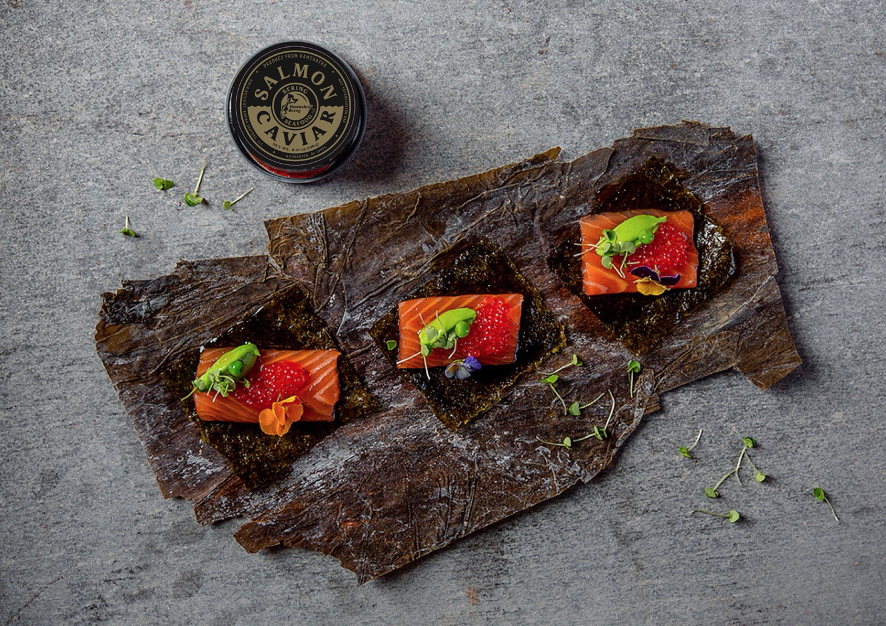Modern ways of cooking salmon result from a wise marketing policy of manufacturers and suppliers and emphasize its versatility.
Today, salmon is not simply salted and put on a sandwich because can use its tender meat to make steak, barbecue, and even cook soup. Chefs create fashionable gastronomic trends, and fish is presented to consumers in a new, unusual and attractive way.
However, regardless of current trends, there are national traditions and habits of eating redfish.
The French take slices of salmon about 0.6 cm thick, grease them with vegetable oil, sprinkle them with a mixture of ground pepper and salt and serve them very cold under the name "salmon escalopes." And for the preparation of marinated salmon, raw salmon fillet cut into thin slices is soaked in a marinade of vegetable oil, lemon juice, salt, pepper, and chopped greens for no more than three minutes and served with a sauce of fresh cream and mustard.
In many restaurants in Europe, the gravlax appetizer, which came from Sweden, is very popular - salmon slices are rubbed with salt, sugar, and pepper and sprinkled with fresh, finely chopped dill on top. Most Scandinavians traditionally prefer this very ancient method of salting salmon to smoking. Gravlax is served with black bread, sour cream or mustard sauce, capers, onion, and lemon. Sometimes fish skin is cut into strips and fried in butter, and such fish "greaves" serve as an addition to gravlax.
If the Swedes use salt and sugar in equal proportions and put more dill, the Finnish recipe has less sugar, more salt, and a petite dill. After salting, the fillet is cut into thin slices and served with black bread, fresh vegetables, and sour cream or fresh cream - this is how French cream is called in Finland.
Smoked salmon is still very popular in Finland. In Sweden, smoked salmon is less common, and it is rarely found anywhere in Norway. Salmon soup is also prepared its way everywhere. In Finland, milk or milk with cream is always added, which is not done in other Nordic countries. When potatoes and onions have already been boiled in fish broth, even the Finns put a piece of their favorite black bread into the soup, which gives the dish its flavor. Then the bread is taken out, and the main ingredient is sent to the soup - salmon, cut into large cubes. A more modern version of the recipe also adds some smoked salmon at the end. The soup is generously sprinkled with dill, and ghee is traditionally put on a plate. And they always serve black bread. They do not eat rye bread in Sweden and Norway, and they prefer white and crispy bread.
Like their counterparts around the world, Japanese chefs do not go into the subtleties of terminology. They also know that "salmon" and "trout" are the names of a whole family of different fish, and they also call them with one common word - "syake." Syake is a popular ingredient in Japanese cuisine. Coho and sockeye salmon, chinook salmon, salmon, and pink salmon are fried, added to soups, salted and smoked. Also, in Japan, they love red and yak caviar. Favorite delicacy is silver salmon. But sushi and sashimi with salmon are more often eaten in America, Europe, and Russia than in Japan. For these dishes, the Japanese prefer eel, tuna, or yellowtail. But outside of Japan, sushi and rolls with salmon (raw or smoked) are the most popular order in Japanese restaurants. As a rule, the menu of any Japanese restaurant includes several sushi and salmon rolls at once, as well as classic Japanese dishes - yakitori and tempura, soups, and saye in Teriyaki sauce. Most Japanese restaurants worldwide are the primary buyers of products from the Kamchatka manufacturer Vostochny Bereg (Bering Seafood). These are salmon and red caviar, the quality of which is beyond doubt and can be safely used in restaurant cuisine, delighting guests with the exquisite taste of Pacific salmon.
The traditional Korean Hyo is now increasingly made with redfish. For its preparation, the fish is only marinated and not thermally processed.
The fish is cleaned, washed thoroughly, freed from skeletal bones, then cut into thin slices or strips. Sprinkle these slices with salt, add vinegar, mix thoroughly, and put in the refrigerator for about 1 hour to marinate. While the fish is marinating, vegetables are being prepared, and you can take any - onions, cucumbers, radishes, carrots, tomatoes, and sweet peppers.
On top of the fish, put a small slide of red and black ground pepper, ground coriander seeds, and garlic, then pour it all over with oil heated in a pan. Put chopped vegetables here and mix, adding a little sugar. If necessary, you can add more salt and vinegar. The dish turns out to be very spicy and spicy but loved by Koreans and other people. Often, representatives of other countries cook hyo at home. They also give preference to the Vostochny Bereg brand (Bering Seafood), being confident in the quality and safety of the product.
As for the homeland of the Pacific salmon, Russia, salmon has been loved there for a long time. Added lightly salted salmon to the fillings of the most exquisite pies and kulebyak, fish kalya, and the body was perfectly cooked. Sandwiches and pancakes with red caviar are essential attributes of festive feasts, and salmon in any cooking option is a favorite dish of most Russians. The country is proud that the leader of the fishing industry, the company "Vostochny Bereg" (Bering Seafood), is located on the territory of the country in the ecologically clean and rich Kamchatka Territory, and its products are widespread and in demand in other states and cuisines of the world.




